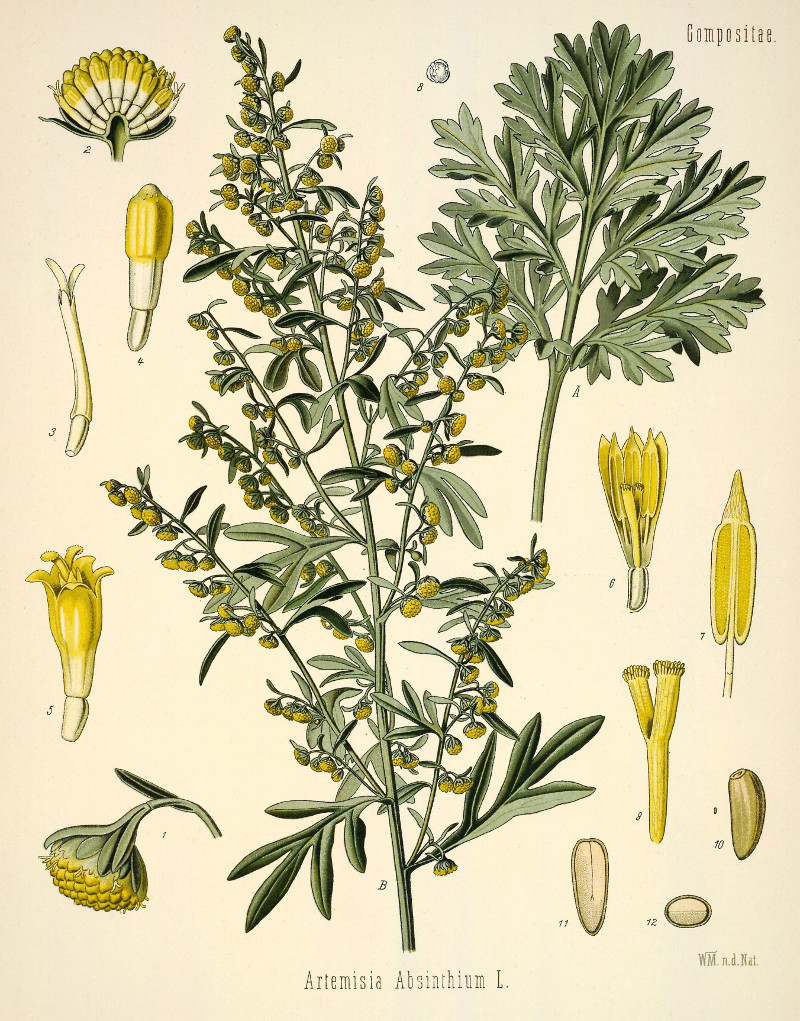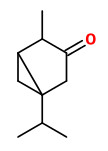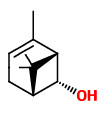Artemisia absinthium L.- syn.Absinthium officinale Lam.; Absinthium vulgare Lam.; Absinthium majus Geoffr. - Asteraceae
wormwood, Wermut, Absinth, Wurmkraut, Bitterer Beifuss
Upright aromatic perennial, 0,60-1,20m high, native to Eurasia, naturalized in North America; stem branched, with silky hairs; leaves grey-green, deeply dissected, with silky hairs on both sides; panicles of pendulous flowerheads, these 2,5-4mm across, with yellow tubular florets.
The sesquiterpene lactone dimer absinthin accounts mainly of the bitterness of wormwood (Absinthii herba). It is responsible for some digestive effects of wormwood, like enhancing appetite and promoting the flow of bile.
„Wormwood (Artemisia absinthium L.) essential oil obtained by steam distillation has been investigated by GC and GC/MS. The main component was determined to be either (α + β) thujone or cis-chrysanthenol, depending upon the maturation state of the plant. In wormwood harvested after flowering period (October or November), the amount of cis-chrysanthenol may reach more than 60%. The wormwood growing in Auvergne could be considered to be a new chemotype; a cis-chrysanthenol chemotype.“
[cis-Chrysanthenol, a main component in essential oil of Artemisia absinthium L. growing in Auvergne (Massif Central), France. Carnat, A. P., Madesclaire, M., Chavignon, O., Lamaison, J. L., Journal of Essential Oil Research, Vol.4(5), 1992, 487-490]
„Several essential oils obtained from Artemisia absinthium L. from four localities in the Spanish Pyrenees were analyzed by GC/MS. Two chemotypes were detected; a cis-epoxyocimene type (with more than 50% of this compound) which was predominant in all the populations, and a cis-epoxyocimene + chrysanthenyl acetate type (with 25-65% of cis-epoxyocimene and 15-50% of chrysanthenyl acetate). The distribution of these chemotypes had no relation with the altitude of the samples. None of the plants tested contained thujone, a fact which could be very interesting for the food industry.“
[Essential oil of Artemisia absinthium L. from the Spanish Pyrenees. Ariño, A., Arberas, I., Renobales, G., Arriaga, S., Dominguez, J. B., Journal of Essential Oil Research, Vol.11(2), 1999, 182-184]
„The essential oils obtained by steam distillation from the aerial parts of two populations of Artemisia absinthium, from France and from Croatia, were analyzed by GC and GC-MS. The oils of A. absinthium of French origin contain (Z)-epoxyocimene and chrysanthenyl acetate as major components while the oils of Croatian A. absinthium contain mainly (Z)-epoxyocimene and β-thujone. Analysis of oils before and after anthesis showed some quantitative differences. Analysis of separated leaves and flowering heads showed only few differences among these organs. As they contain no thujone, antimicrobial screening was performed on samples of French origin and showed that A. absinthium oil inhibited the growth of both tested yeasts (Candida albicans and Saccharomyces cerevisiae var. chevalieri).“
[Composition and Antimicrobial Activity of the Essential Oil of Artemisia absinthium from Croatia and France. Juteau, F., Jerkovic, I., Masotti, V., Milos, M., Mastelic, J., Bessiere, J. M., Viano, J., Planta medica, 69(02), 2003, 158-161]
„Wormwood contains a dark green to brown, rarely blue, smelly, scratching bitter tasting essential oil (0.2-1.5%). The most frequently encountered chemotype contains the bicyclic monoterpene thujone as the main component (40-90% of the essential oil). Depending on the stereochemistry of the C-4 methyl group there are two thujone isomers: α- and β-thujone. β-thujone is present in higher concentration than α-thujone (β-thujone: 70-90% of total thujon)…
In addition to the β-thujone chemotype, there are more chemotypes with cis-chrysanthenyl acetate, cis-chrysanthenol, cis-epoxycimene, sabinylacetate, bornyl acetate or α-phellandrene as a main component. The cis-epoxyocimene type is predominant in the western Alps at altitudes over 1000 m, while the β-thujone type is more common in lower zones. In wormwood oil from Tuscany or the Spanish Pyrenees, neither α- nor β-thujone could be detected, so that these chemotypes are ideally suited for the spirits industry. Absinthe with wormwood quantities of historical recipes can therefore be produced without the risk for the manufacturer to pass the thujone limit.“
[Authentifizierung von alkoholischen Getränken mittels GC/MS und HPTLC: Absinth - Kultdrink oder Fusel?, Lachenmeier Dirk W., Chemie in Labor und Biotechnik, Vol.56, 2005, 18-21] http://www.analytik-news.de/Fachartikel/Volltext/CLB12.pdf
„… α-thujone acts at the noncompetitive blocker site of the GABAA receptor and is rapidly detoxified, thereby providing a reasonable explanation for some of the actions of absinthe other than those caused by ethanol, and allowing more meaningful evaluation of risks involved in the continued use of herbal medicines containing α-thujone.“
[α-Thujone (the active component of absinthe): γ-aminobutyric acid type A receptor modulation and metabolic detoxification., Höld, K.M., Sirisoma, N.S., Ikeda, T., Narahashi, T., Casida, J.E., Proceedings of the National Academy of Sciences, 97(8), 2000, 3826-3831]
Comparision of thujone content in commercial Absinthe by HS-SPME/GC showed a great variability, ranging overall from 0.1-55.8 mg/l (with α-thujone 0.1-9.0mg/l and β-thujone 0.1-55.8 mg/l).
[Bestimmung von α-und β-Thujon in Spirituosen mittels Festphasenmikroextraktion (HS-SPME): Vergleich mit konventionellen Extraktionsmethoden., Schäfer, N., Lachenmeier, D.W., Deutsche Lebensmittel-Rundschau, 101(12), 2005, 534-539]
Major volatile components of 70 examined samples of Absinthe were α- and β-thujone, fenchone and linalool. In aniseed-containing absinthe, anethole also has been detected. The aromatic herbal wormwood flavor (reminiscent of chamomile), and an overall high quality revealed the best correlation with α- and β-thujone. The ouzo effect (turbidity when diluted with water) correlated at best with linalool and sesquiterpenes. There was a very large variability of thujone content present in the group of high-quality absinthe. Only individual French products, and two products manufactured according to traditional recipes in the Swiss Val-de-Travers, showed relatively low thujone content, although a significant wormwood flavor was present. A sole rejection of absinthes by their limited content of thujone is thus regarded as problematic, especially as the demand for a minimum content for a restricted toxic substance seems critically. Origin from the wormwood plant can be considered safe, when β-thujone clearly predominates the α-isomer in content. Among the tested products of French origin with higher quality, there were some with uncharacteristically larger α-thujone content - another chemotype of Artemisia absinthium L. could be responsible. For many products, in which the α-isomer predominates, the thujone has been not or not exclusively made of wormwood - but maybe from cedar (which has α-thujone up to 85% of thujones).
[Authentifizierung von Absinth-bittere Wahrheit über eine Legende., Lachenmeier, D.W., Emmert, J., Sartor, G., Deut. Lebensm.-Rundsch, 101, 2005, 100-104] http://www.academia.edu/download/32834851/Absinth_100_104_DLR-2005k.pdf
„After the recent annulment of the absinthe prohibition all analysed products showed a thujone concentration below themaximum limit of 35 mg/l, including the absinthes produced according to historic recipes, which did not contain any detectable or only relatively low concentrations of thujone (mean: 1.3-1.6 mg/l, range: 0-4.3 mg/l). Interestingly, the vintage absinthe also showed a relatively low thujone concentration of 1.8 mg/l. The Val-de-Travers absinthes contained 9.4 and 1.7 mg/l of thujone. In conclusion, thujone concentrations as high as 260 mg/l, reported in the 19th century, cannot be confirmed by our study. With regard to their thujone concentrations, the hallucinogenic potential of vintage absinthes can be assessed being rather low because the historic products also comply with today’s maximum limits derived to exclude such effects. It may be deduced that thujone plays none, or only a minor role in the clinical picture of absinthism.“
[Lachenmeier, Dirk W., et al. „Thujone—Cause of absinthism?.“ Forensic science international 158.1 (2006): 1-8]
„Variations in the essential oil composition of Artemisia absinthium L. obtained from different geographical areas of Europe were determined using capillary gas chromatographic and mass spectrometric analysis methods. The oils from air-dried wormwood were obtained in yields of 0.1-1.1%. The Absinthii herba grown in Estonia corresponded to the EP standards in the aspect of the essential oil contents. A total of 107 components were identified, representing over 85% of the total yield of oil. The principal components in the oils were sabinene (0.9-30.1%), myrcene (0.1-38.9%), 1, 8-cineole (0.1-18.0%), artemisia ketone (0-14.9%), linalool and α-thujone (1.1-10.9%), β-thujone (0.1-64.6%), trans-epoxyocimene (0.1-59.7%), trans-verbenol (0-11.7%), carvone (0-18.5%), (E)-sabinyl acetate (0-70.5%), curcumene (0-7.0%), neryl butyrate (0.1-13.9%), neryl 2-methylbutanoate (0.1-9.2%), neryl 3-methylbutanoate (0.4-7.3%), and chamazulene (0-6.6%). Monoterpenes were predominant (44.0-67.9%) in the oils from Scotland, Estonia (2000, 2002), Moldova, and Hungary. In the other oils studied oxygenated monoterpenes (41.2-93.9%) were found to predominate. The highest content of oxygenated sesquiterpenes (11.9-29.8%) was found in the oils from Italy, Latvia, Lithuania, and Germany. Armenian oil contained more chamazulene (6.6%) than the other samples studied (0-2.1%). Four chemotypes were found to be characteristic of A. absinthium growing in Europe: sabinene and myrcene rich oil, α- and β-thujone rich oil, epoxyocimene rich oil, and (E)-sabinyl acetate rich oil. Some mixed chemotypes were also found.“
[Composition of the essential oil of Artemisia absinthium L. of different geographical origin. Orav, A., Raal, A., Arak, E., Müürisepp, M., Kailas, T., Proc. Estonian Acad. Sci. Chem, 55(3), 2006, 155-165] http://www.kirj.ee/public/va_ke/chem-2006-3-4.pdf
„Although the data base for determining exposure limits is of variable usefulness, the best estimates for allowable daily intakes [of thujone] via herbal preparations and diet are of the order of 3-7 mg/day.“
[Thujone and thujone-containing herbal medicinal and botanical products: Toxicological assessment., Pelkonen, O., Abass, K., Wiesner, J., Regulatory Toxicology and Pharmacology, 65(1), 2013, 100-107]

Köhler,F.E., Medizinal Pflanzen, vol.1 t.68 (1887) [W.Müller]
http://plantgenera.org/species.php?id_species=91181
Artemisia absinthium
© Rolf Marschner (2009),
www.botanische-spaziergaenge.at


